Challenge the Mystery of Cyanobacteria--The Key to Glacier Shrinkage Due to Global Warming
Chuo-Online: Interview with Young Researcher
Ayumi Kizawa
Assistant Professor, Department of Biological Sciences, Faculty of Science and Engineering, Chuo University
Interviewer: Tomokazu Fukui (URA at Research Promotion Office)
-Chuo University is home to many famous researchers who are well-established in various fields. Our university also boasts many young researchers who are in the prime of their research at this very moment. This article is the first in a series for introducing such young researchers to the world. The article features Assistant Professor Ayumi Kizawa (Department of Biological Sciences, Faculty of Science and Engineering), who conducts research on glacier ecosystems.
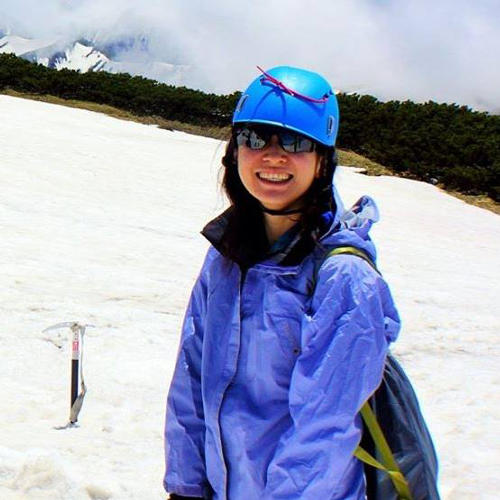
-Please briefly explain your research theme.
The term "cryosphere" refers to an environment covered with snow and ice, such as high latitudes and high mountains. As everyone knows, global warming has a tremendous impact on the cryosphere, including glaciers. At first glance, the cryosphere appears to be a lifeless world with only snow, ice, and bare rocks, but it actually nurtures its own ecosystem. Global warming has a direct impact on living organisms in the cryosphere. Among them, photosynthetic organisms called cyanobacteria play an important role as primary producers supporting glacier ecosystems. Unfortunately, in recent years, it has become clear that large proliferation of cyanobacteria on glacier surfaces has polluted those surfaces and accelerated glacier surface melting.
Kizawa actually preferred to stay indoors as a child!? The road to becoming a researcher
-Before discussing your research, I would like to learn a little more about you as a person. You are an adventurous researcher who travels around the world in search of glaciers. I assume that you have loved adventure since you were a kid?
Although I was very intellectually curious as a child, I preferred reading books at home rather than going out to play.
-So, you actually enjoyed staying indoors as a child? That is surprising. What made you decide to pursue a career as a researcher?
When I was in elementary school, we had copies of the science magazine Newton in our classroom. Reading the magazine made me feel that scientists had such a cool job. The direct reason I chose a department of biology at university was because I found it interesting to listen to my biology teacher in high school. That teacher had not graduated from a school of education, but from a department of biology in a faculty of science. The teacher often discussed practical training and research that was performed at university. I found such stories to be infinitely more interesting than the material printed in textbooks, and I began to feel that studying at a biology department would be fun.
-I see. Your high school biology teacher was your first influential instructor. Why did you start researching cyanobacteria?
I was interested in the evolution of living things, so at university I decided to do my graduate research under the guidance of a professor who was studying the photosynthetic prokaryote cyanobacteria, which is considered to be the ancestor of plants. At that time, clarifying the mechanism in which cyanobacteria change intracellular metabolism in response to environmental changes was a major theme.
-Would you please explain why you decided to conduct research at Chuo University?
The cyanobacteria which I was studying had been isolated from the field decades ago and cultivated in the laboratory ever since. As I proceeded with my research, I became curious regarding the life of cyanobacteria existing in nature. After researching the literature, I was particularly intrigued by cyanobacteria that have adapted to cold environments and inhabit polar regions and glaciers. Few scientists in the world are researching cyanobacteria isolated from cold environments. However, Dr. Makiko Kosugi, who happened to be at Chuo University, was conducting physiological analysis of cyanobacteria culture isolated from a glacier in the Arctic region. I had the good fortune to connect with Dr. Kosugi and decided to join Chuo University.
Life spent in researching glaciers
-What tasks do you normally perform at Chuo University?
I conduct cyanobacterial culture experiments and analyze environmental samples collected from glaciers. Glacier surveys are conducted jointly, not by individual researchers. Therefore, I sometimes create materials for discussing the survey plan with other researchers. I had wanted to explore glaciers abroad as much as possible every summer, but unfortunately, I was unable to conduct onsite research last year due to the global COVID-19 pandemic.
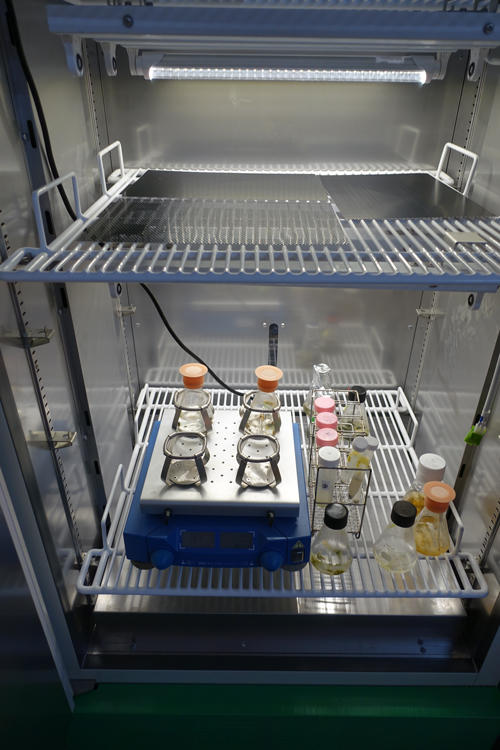
State of cyanobacteria culture
-Just listening to you discuss glacier surveys held overseas gets me excited!
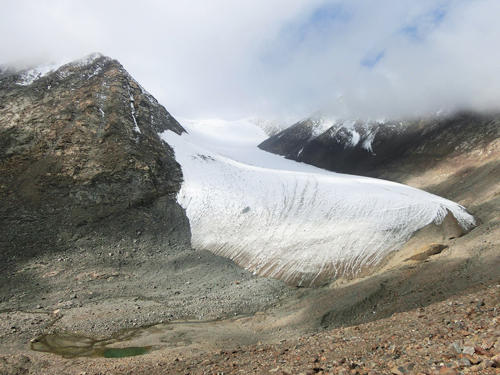
Urumqi No.1 Glacier
The first glacier I actually visited was the Urumqi No.1 Glacier in the Tianshan Mountains of China (see the photo above). This glacier has a rich history and has been observed longer than any other glacier in Asia. I was deeply moved by this history and thrilled to simply stand at an altitude of 4,000 meters. I remember thinking that I had come to such a wondrous place after just having been researching cultures in a laboratory a few days beforehand.
During the survey, we set up our tents in a location where we are able to reach glaciers on foot. We then spend our days walking back and forth to survey areas which we can reach from the edge of the glacier. During these expeditions, we carry gear such as survey devices and equipment on our backs (see the photo below). We spend a long time of nerve-wracking walking on top of glaciers, and we have to be careful to avoid accidents during the survey. It is both mentally and physically exhausting.
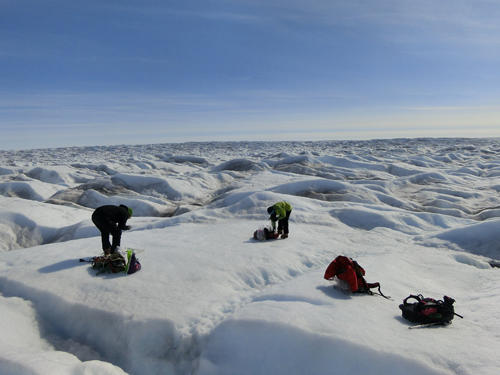
Scene of a survey
-What did you think when actually seeing a real glacier with your own eyes?
I have only been to a few glaciers so far. From a distance, every glacier is magnificent and beautiful work of art. However, when actually standing on a glacier, I feel the true harshness of the environment. Then, after returning to Japan, I am amazed to peer through my microscope and observe small organisms in the samples collected from the glacier. It is astounding to find life in such a harsh environment.
Pursuing the secrets of glacier cyanobacteria
-Moving on, I would like to ask you more about your research. In the first place, I was surprised to learn that there are living organisms and ecosystems in glaciers.
Our planet has a diverse variety of ecosystems. In Japanese, the word glacier is formed from the Chinese characters for "ice" and "river." As implied by this name, glaciers are a fluid environment, and therefore are not suitable for the breeding of ordinary organisms. Therefore, many types of organisms that are resistant to cold and oligotrophic environments have been found in glaciers. This small ecosystem has a limited number of species, one of which is cyanobacteria that are the primary producers of organic substances by photosynthesis. Other living organisms include heterotrophic bacteria that decompose organic substances and predators such as insects. Just like any other ecosystem, glaciers have a food chain.
-I cannot believe that even insects live on glaciers! It is said that glaciers are affected by global warming. Could you discuss the exact mechanism that is taking place?
Glaciers have a growth phase due to snowfall and a thinning phase in the warmer months. If these two phases are balanced, the mass of the glacier will not change. The rise in annual average temperature due to global warming has led to a longer period of glacier melting. This disrupts the mechanism that maintains the mass of ice and causes glaciers to shrink around the world.
-If I am correct, cyanobacteria need fertilizer for photosynthesis and growth. Do glaciers contain such a substance?
Ice does not possess fertilizer. However, wind, rainfall, and snowfall supply inorganic nutrients from soil surrounding the glacier. These nutrients serve as fertilizer. Nutrients are also required for cyanobacteria to photosynthesize. Organic matter produced by photosynthesis is a valuable nutrient for other heterotrophic organisms.
-I have heard that glaciers will lose their white color as cyanobacteria increase.
That's right. It is known that when the organic matter produced by photosynthesis decomposes and humifies, the glacier surface darkens and the reflectance of solar radiation (albedo) on the ice surface decreases. As the albedo decreases, the glacier surface becomes more likely to warm. This phenomenon is similar to the absorption of solar heat by a black umbrella. Today, based on models of climate change due to global warming, we can see that the problem of rapid melting of glacier surfaces is being exacerbated faster than expected.
-It's ironic that the same cyanobacteria which have adapted to the harsh glacier environment are now accelerating the effects of global warming. However, in order to solve this problem, it seems necessary to start by learning more about the ecology of cyanobacteria in glaciers.
Yes, researchers now know that the photosynthesis and reproduction of cyanobacteria on glaciers is one of the factors which accelerate glacier melting. However, little is known about how cyanobacteria breed on glaciers, their breeding process, or the environmental adaptation strategies that support breeding. To clarify these items, researchers are analyzing both environmental samples containing cyanobacteria collected from glaciers and isolated cultures of cyanobacteria. On glaciers, cyanobacteria are found on the surface and inside of granules called cryoconite granules. These granules have a diameter of 1 to 2 mm and contain mineral particles (see the figure below). Researchers are investigating the actual state of breeding on glaciers by investigating what species of cyanobacteria are present in cryoconite granules and measuring photosynthetic activity on-site. Furthermore, by culturing cyanobacteria under various conditions in the laboratory, we are investigating the fertility and environmental stress tolerance of cyanobacteria.
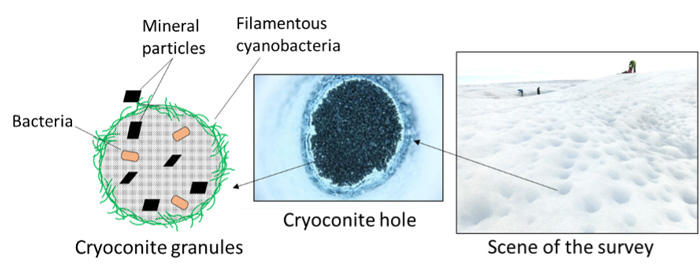
-What has your research revealed thus far?
In my previous research, I have investigated the substances and bioactivity produced by cyanobacteria. I learned that cyanobacteria have used multiple mechanisms to increase their resistance to environmental stresses which reduce their reproductive rate on glaciers. For example, cyanobacteria secrete polysaccharides outside the cell to prevent the inside of the cell from freezing. Moreover, the photosynthetic mechanism is easily damaged if the light is too strong at low temperatures. In response, cyanobacteria produce a substance outside of the cell to absorb harmful light.
-It is amazing how these small cyanobacteria change the surrounding environment for their own convenience. How can your research results be put to good use?
By conducting a detailed examination for the potential of cyanobacteria inhabiting glaciers, it is possible to predict if future global warming will cause cyanobacteria to expand their breeding locations on glaciers or accelerate their breeding rate. We are also able to forecast their breeding. We believe that predicting the extent of cyanobacteria growth will improve the accuracy of glacier melting forecasting. Furthermore, I hope that my research will be of use from the perspective of SDGs. For example, the research can assist in formulating measures for securing water sources for people in mid-latitude areas who use glacier meltwater as their domestic water source, and can identify how the inflow of glacier meltwater will affect marine resources downstream of the glacier.
-What do you want to investigate next?
Cyanobacteria have been confirmed to inhabit glaciers around the world. Yet, for some reason, there are endemic species that are only found in certain areas, as well as species that inhabit in a wide range of areas from the Arctic region to the mid-latitude region of Asia. The reason for this distribution is still unknown. Although I am currently not able to conduct research overseas due to the spread of COVID-19, I hope to isolate cyanobacteria from glaciers in various regions, and then compare the samples in terms of fertility and environmental adaptation strategy mechanisms.
Conclusion
-Please give a message to students who are about to embark on their research, and to researchers active in different fields.
When I started researching cyanobacteria in my senior year at university, I never imagined that investigating the life of microorganisms with a diameter of about 2 micrometers would lead to the global environmental problem of glacier melting. Students who start their research may find new interesting things when studying an issue from various perspectives. Researchers from different fields are collaborating on glacier surveys, so please contact us if you are interested--even if biology is not your field of expertise.
Actually, I have seen glaciers in Iceland and Mount Kenya. However, I never knew that such glaciers possess their own ecosystem. I will continue to pay attention to research on cyanobacteria, small organisms that affect the global environment.
The Research Promotion Office is looking for young researchers to be introduced in this series. If you are interested, please contact an URA at the Research Promotion Office (chuo-ura-grp@g.chuo-u.ac.jp).
Ayumi Kizawa
Assistant Professor, Department of Biological Sciences, Faculty of Science and Engineering, Chuo UniversityAyumi Kizawa was born in Fukushima Prefecture in 1984.
In 2008, she graduated from the Department of Biochemistry & Molecular Biology in the Faculty of Science, Saitama University.
In 2011, she completed the Master’s Program in the Graduate School of Life Sciences, Tohoku University.
In 2016, she completed the Doctoral Program in the Graduate School of Science and Engineering, Saitama University. She holds a PhD in science.
In 2016, she served as a corporate doctoral research fellow in the Department of Agricultural Chemistry, the School of Agriculture, Meiji University.
In 2018, she served as a specially-appointed researcher in the Graduate School of Science and Engineering, Tokyo Metropolitan University and a technical assistant at Chiba University.
Since 2019, she has been serving as Assistant Professor in the Faculty of Science and Engineering, Chuo University.








